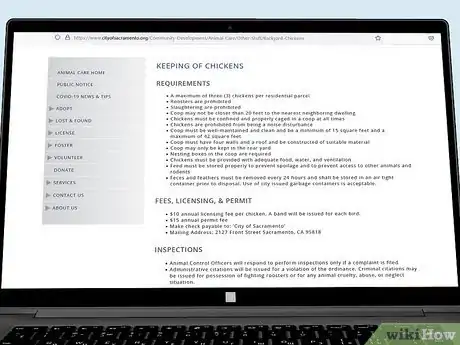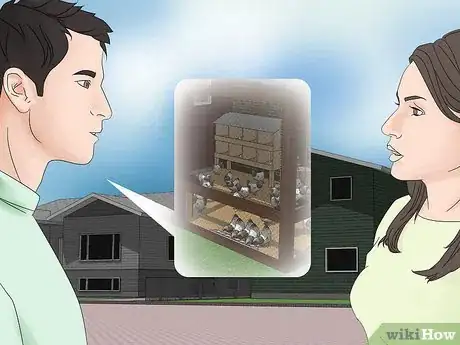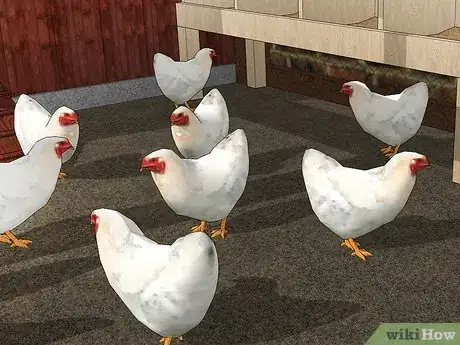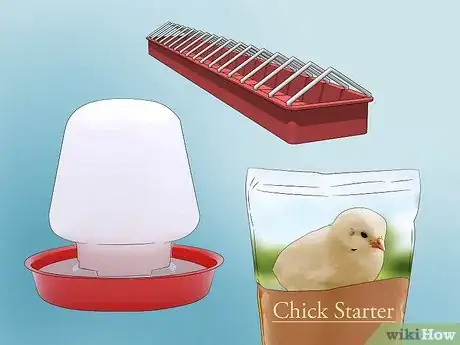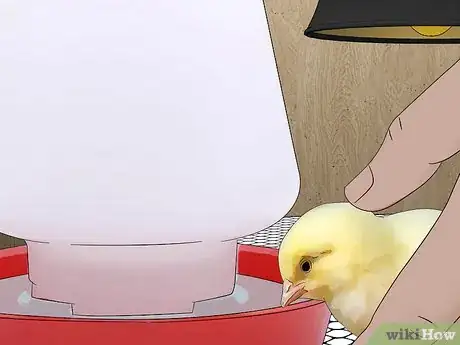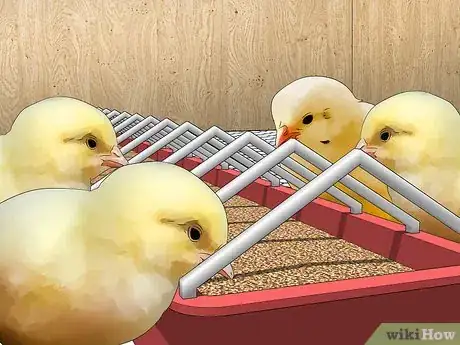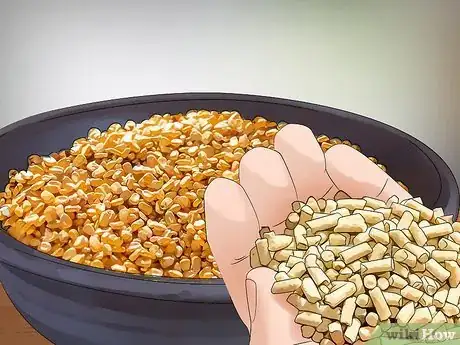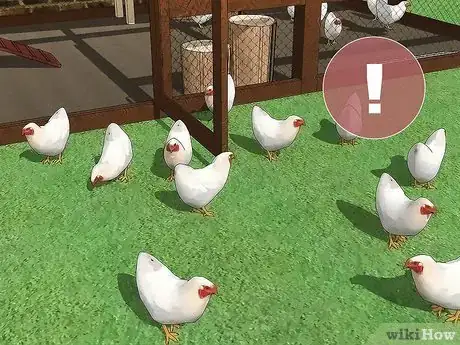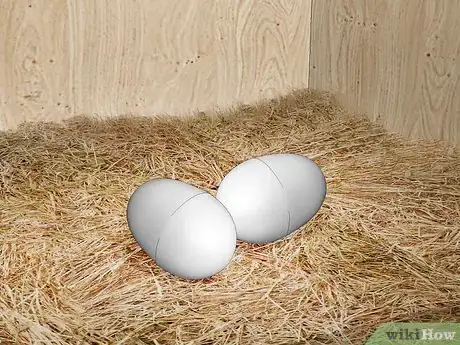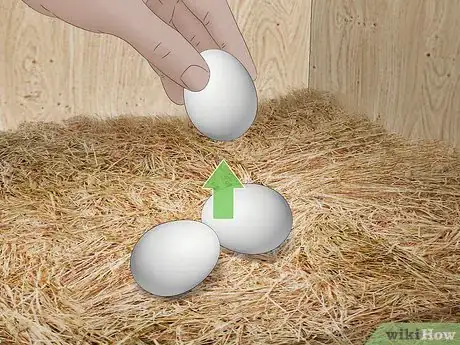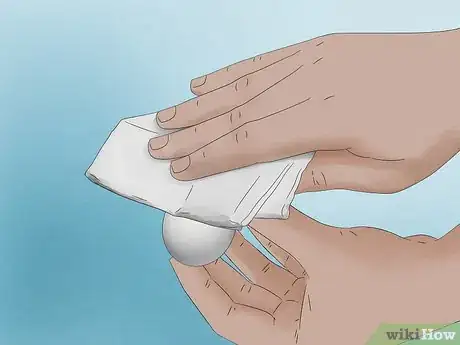wikiHow is a “wiki,” similar to Wikipedia, which means that many of our articles are co-written by multiple authors. To create this article, 20 people, some anonymous, worked to edit and improve it over time.
wikiHow marks an article as reader-approved once it receives enough positive feedback. This article received 19 testimonials and 100% of readers who voted found it helpful, earning it our reader-approved status.
This article has been viewed 219,745 times.
Learn more...
Raising chickens can be a fun family activity for urban homesteaders or rural homes. Many people come to think of their chickens as pets, as well as food providers. To keep your chickens and eggs safe, you must invest in a coop and brooder, protect hens from predators and protect yourself and the animals from harmful bacteria. Follow these tips to raise chickens for eggs.
Steps
Planning a Chicken Coop
-
1Find out if it is legal to raise chickens on your land. Many cities have ordinances against raising chickens in city lines.
- It is a good idea to search for town ordinances and to check with your homeowner’s association. They may have additional restrictions.
- Most cities have stricter laws about roosters than chickens. If you want a rooster in order to grow chickens for meat, you may have more trouble.
-
2Talk to your neighbors. Chickens make a fair amount of noise. Don't have roosters if you have neighbors close by; the roosters may disturb the neighbors!
- Chickens will still squawk, but rest assured they will not crow like roosters.
- Consider offering your neighbors free eggs every few weeks. They may be more amenable to the idea if they reap some benefits. [1]
Advertisement -
3Make sure you have enough time in your schedule to care for chicks and chickens. You will need to stay at home the first day the chicks arrive, and clean and harvest eggs most days of the year. If you have to work long hours, this responsibility may not be for you.
-
4Set aside an area in your backyard for the chicken coop. If you are raising the birds from chicks, you'll have a little bit of time to build it while they grow. If you are buying older hens, you will need the coop immediately.
Making a Chicken Brooder/Coop
-
1Buy a chicken coop before your chickens are 2 months old. Search online for people who make chicken coops in your area, and you may be able to pick up a newly made model to avoid shipping. You can also get plan to build a coop online.
- Look for a coop or design with lots of light, so your chickens will be happy.
- Choose a coop with a run, so that chickens can roam, but be protected during the day.
- You can buy a chicken coop from Amazon, Williams Sonoma, Petco and numerous other outlets.
- You can also buy a chicken tractor, which is a portable chicken run.
-
2Reinforce your chicken coop. Predators, such as raccoons, mountain lions, bobcats and even dogs, can slip through cracks or underneath coops. Invest some money in extra chicken wire, nails and wooden or stone borders.
-
3Prepare your brooder/coop before you bring chicks home. Add bedding, feeders and a heat lamp.
Choosing Chickens
-
1Consider buying hens. They are often available in the fall, after people have raised too many chicks for their needs. However, it is hard to distinguish hens that are near the end of their egg-laying years (over 2 years old) from those who are young with many egg-laying years ahead of them, so vet your farm or seller well. [2]
-
2Opt for buying chicks rather than hatching eggs the first year you raise chickens. Hatching eggs are available through purchase by mail order and in stores. While they may be cheaper than chicks, they may not have the sex determined and some eggs do not hatch.
-
3Set up your brooder before you take the chicks home. A brooder is a heated nesting place that will keep chicks warm. They cannot regulate their body temperature for the first few weeks of life.
- Find a thick cardboard or plastic box. It should be smaller when the chicks are small, and then you should replace it incrementally as they grow.
- Place the box in an area of your house that has a steady temperature.
- Pour 1 inch (2.5 cm) of pine shavings into the bottom of the box.
- Place a heat lamp on the side of the box. Use a thermometer to keep the temperature at a steady 95 degrees Fahrenheit (35 degrees Celsius).
-
4Purchase a chick waterer, chick feeder and chick starter feed from your local feed store. [3]
-
5Buy day-old chicks at the local feed store or online. You can usually buy them between February and April. Look for “pullets” because they are female.
- A full grown chicken between 2 months and 2 years old will lay approximately 5 eggs per week. In order to get a dozen per week, buy 3 to 4 chickens.
- Make sure your coop size is large enough to accommodate them. There should be 3 to 4 square feet (0.9 to 1.2 square meters) of space per chicken inside the coop and 10 square feet (3 square meters) of space per chicken outside the coop.
-
6Purchase several types of egg-laying chickens. A mixed group will provide varied sizes and colors. The following are some breeds to consider:
- Americana chickens, sometimes called “Easter Eggers” are prized for their colored eggs.
- Other popular breeds are Rhode Island reds, Cochin chickens and Barred Rocks.
- Breeds called Australorps, Orpingtons and Faverolles are considered “winter layers” so it may be worth buying them in cold-weather areas.
- Breeds that are considered “fancy” will lay fewer eggs. They are developed genetically for their looks rather than their egg-laying abilities.
Raising Chickens
-
1Move the heat lamp slightly farther away every week for 8 weeks. Keep it at 95 degrees the first week and decrease by 5 degrees each week until you reach 65 degrees (18 degrees Celsius).
- The week after you reach 65 degrees, you can take the lamp away completely.
- Keep a thermometer in the box so you can accurately judge the temperature. [4]
-
2Dip the chick’s beaks in water the first day you bring them home. They are possibly dehydrated and don’t know how to drink yet. Keep an eye on water levels for the next few months to ensure they are staying hydrated.
- Thirsty/hot chicks will have their beak open and pant.
-
3Buy chick feed for the first few months. Chickens need food with a little sand in it, and baby chick crumbles have already accounted for this. When you replace chickens in later years, you can try mixing your own scraps with sand.
-
4Move the chickens outdoors to their coop after 2 months. If it is still very cold in your area, you might want to wait a little longer.
-
5Feed your chickens varied food to make deeper yolks. They can eat store-bought chicken crumbles, food scraps, insects from the lawn, night crawlers, grass and corn. Cracked corn is essential in the winter to keep their body temperature up.
- Free-range eggs have lower cholesterol and saturated fats than store bought eggs. They also have higher omega-3 fatty acids. [5]
-
6Avoid letting your chickens roam free without supervision. Although you may want them to have freedom, they will become prey.
- Let them out to run around when you are doing yard work or playing in the lawn.
- Keep them in the run until nightfall, and then close up the coop.
Gathering Eggs
-
1Place a fake egg in the nesting boxes of young hens. Make sure it is not a real egg, or they can get into the habit of eating eggs. They need to be shown where to lay their eggs.
- In later years, having chickens of varying ages helps teach new hens how to behave. Most sources suggest replacing 1/4 to 1/3 of the flock each year.
-
2Gather eggs each day to free up the nesting boxes.
-
3Wipe the eggs with a soft cloth, which removes mess, but not the anti-bacterial bloom on the egg. Mother hens produce this coating to protect their eggs from disease.
-
4Store eggs at approximately 45 degrees Fahrenheit (7.2 degrees Celsius). They should be stored in the refrigerator rather than at room temperature. Warmer temperatures can promote bacterial growth.
-
5Protect against salmonella. The following habits will prevent backyard hens from producing contaminated eggs.
- Wash eggs that are covered with chicken feces. Roll them around in a sanitizer with 1/2 oz. (14.8 ml) of chlorine to 1 gallon (3.8 l) of water.
- Eat eggs quickly. Older eggs have a higher risk of contamination as the egg white breaks down.
- Place chicken manure in a composter for 45 to 60 days before adding it to vegetable beds. Fresh chicken manure may contaminate vegetables with salmonella.
- Keep potentially contaminated eggs away from pregnant women, young children or chronically ill people, who have a higher chance of infection. [6]
Community Q&A
-
QuestionCan you use sand as grit?
 Community AnswerNo. Sand and grit are not the same. Grit is more like tiny rocks that chickens need to help digest their food.
Community AnswerNo. Sand and grit are not the same. Grit is more like tiny rocks that chickens need to help digest their food. -
QuestionHow many chickens I need to start with?
 Community AnswerIf you want a dozen eggs a week, then around 4 chickens is good, but you can start with fewer chickens if you don't need that many eggs.
Community AnswerIf you want a dozen eggs a week, then around 4 chickens is good, but you can start with fewer chickens if you don't need that many eggs. -
QuestionCan chicks and hens survive in the winter? How do you care for them in the cold?
 Community AnswerChicks require a heat lamp during the winter, and so do the hens if temperatures get too low. Avoid letting the chickens out into the snow as this can cause frostbite. Supplement them with a chicken scratch, too.
Community AnswerChicks require a heat lamp during the winter, and so do the hens if temperatures get too low. Avoid letting the chickens out into the snow as this can cause frostbite. Supplement them with a chicken scratch, too.
Things You'll Need
- Chicken coop
- Chicken run/tractor
- Brooder
- Heat lamp
- Thermometer
- Chick starter feed
- Chick waterer/bowls
- Water
- Day-old chicks
- Kitchen scraps
- Cracked corn
- Chicken crumbles
- Soft cloth
- Refrigerator
- Chlorine
- Compost pile
References
- ↑ http://www.backyardchickens.com/a/how-to-raise-backyard-chickens-in-your-city-the-basics-of-raising-chickens
- ↑ http://www.yummymummykitchen.com/2013/04/all-about-raising-chickens-and-eggs.html
- ↑ http://www.yummymummykitchen.com/2013/04/all-about-raising-chickens-and-eggs.html
- ↑ http://www.artofmanliness.com/2013/03/26/how-to-raise-backyard-chickens/
- ↑ http://www.foodsafetynews.com/2011/06/salmonella-risk-in-backyard-chicken-eggs/#.Ul1wY2Q__AY
- ↑ http://www.foodsafetynews.com/2011/06/salmonella-risk-in-backyard-chicken-eggs/#.Ul1wY2Q__AY
About This Article
To raise chickens for eggs, start by purchasing female chicks through the mail or at a local feed store. Then, keep them warm in a brooder and make sure they have access to plenty of water and chick feed. After 2 months, move the hens to a coop outside and feed them a varied diet of food scraps, cracked corn, and insects. Once the hens start laying, collect the eggs every day to free up the nesting boxes and encourage the chickens to lay more. For tips on how to get your hens to lay in their nesting boxes, read on!
